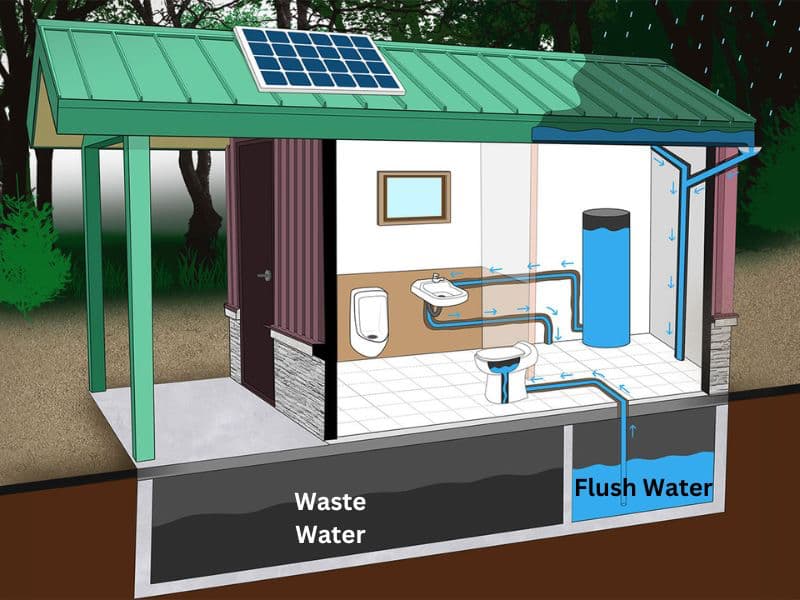Vault toilets are the most typical waterless toilets you will easily find in public areas. They are advantageous because they have little environmental impact and utilize minimal water. Further, they are considered more cost-effective than flushing toilets.
A vault toilet, also called a vault privy, is a toilet where waste is held in an underground vault or tank between 750 to 1000 gallons, with some as large as 13000 gallons. The waste is then pumped out and disposed of in a sewage system. They’re easy to maintain but can have waste management issues.
This type of toilet can be easy to use and convenient in the short run under proper construction. Nonetheless, they appear pretty demanding based on controlling vault waste.

What is a Vault Toilet?
A vault toilet is a waterless toilet that stores its refuse underground in a vast airtight container. Typically, the word ‘vault’ in the vault toilet describes the underground container.
Vault toilets are the best to be located in areas with water shortage issues, such as campgrounds, public spots, and recreational areas.
These toilets are ADA-approved and were initially introduced by the U.A. Forest Service to minimize reliance on standard American toilets.
Vault toilets can be easily constructed using wooden frames, plastic, cross-linked polythene, and reinforced concrete. They are verified to be the most durable toilets, and the most common type is made of polythene.
Vault toilets are considered to have a low risk of pollution since the materials used to assemble them rarely break. Lighter vault toilets are made from lighter objects, making them more portable and simpler to assemble. Other waterless toilets may include bag, pit, and composting toilets.
How Do Vault Toilets Work?
The most common type of vault toilet comprises two parts: the upper part resembling a booth and an underground-dug vault. These toilets’ designs are suitable for all gender and can be assembled for a short period for occasions and other events. Underground vaults have a capacity of 1,000 to 13,000 gallons.
When assembling the vault toilets, the ground is excavated to hold the vault depending on its shape and size. The vault is then immersed in the ground, covering its top with a slab to increase its stability.
The toilet should be assembled on a slope to give the best flow of waste. In addition, a structure should be linked to the slab to offer a connection to the vent pipe.
The municipal council and other service providers will empty these vaults when they are almost full. Most vault toilets are exhausted weekly or after 2 weeks, depending on their usage and the vault size.
Vault Toilets’ Pros and Cons
Some of the benefits and drawbacks of using vault toilets may include the following:
| Pros | Cons |
| Environmentally friendly Convenient Economical Increased privacy Increased portability Flexible for adjustment | Waste management problems Ventilation systems failure Require a steady cleaning routine Require heat for proper functioning Some types are immobile |
Pros
The advantages of using vault toilets include the following:
1. Environmentally friendly
According to statistics, over 7 billion individuals around the globe use flush toilets once daily. This implies a substantial amount of water is used, which is a significant environmental loss.
Vault toilets are waterless toilets that require water only for cleaning. Trucks can also be used to transport water in flush toilets, which can be expensive and detrimental to the environment.
Compared to pit latrines, vault toilets are water-tight and don’t require any uprooter to drip into the ground.
2. Convenient
Vault toilets are suitable for remote forested areas where setting flush toilets can be a hassle. They can be easily set up and used for a long time. This option is convenient for solving possible disasters that would arise without toilets in such areas.
3. Economical
You can easily install a vault toilet at a lower cost compared to the installation cost of modern toilet facilities. For instance, setting up a vault toilet in remote areas can be a great option if you work with a substantial workforce for a long time.
You may spend excess money on flush toilets when vault toilets wouldn’t be an option in such scenarios. Also, accessing water for flush toilets in such areas would be a misery.
4. Increased privacy
Vault toilets are single-unit toilets that allow one person at a time, increasing user privacy. They are also spacious to serve as a changing room or for other activities that cannot be done in public.
5. Increased portability
Plastic vault toilets can be used severally by washing them and moving them to new locations. This increased portability makes them suitable for occasions and public events. You won’t have to worry about toilet placement issues as it is with conventional, permanent toilets.
6. Easily adjustable
You can easily add other features to vault toilets that are not their components. For instance, sanitizer machines and light features can be suitable for enhancing their usage.
Cons
The drawbacks of using vault toilets may include the following:
1. Waste management problems
Vault toilets are small units that quickly fill up with waste when used by many users.
Further, they easily clog, creating unclogging challenges without dismantling them. This can be pretty expensive. Also, the riser can uncover the waste, making them unattractive.
2. Ventilation systems might fail
Few cases have been reported of vault toilets’ ventilation system failure. In such scenarios, the air in the toilet booth will be filled with a bad smell.
3. Require a steady cleaning routine
Vault toilets require a steady cleaning routine to keep them fresh. This can be a significant problem, especially in rural areas where insufficient water is required for cleaning. However, this water is little compared to the amount used to flush toilets.
You may need to buy or make your own toilet snake for some deep stains in the toilet.
4. Require heat for proper functioning
The air-cleaning process will be ineffective where heat is lacking at the top of the vent. This can be attributed to external factors such as rain, cloudy weather, shade, or crowds from buildings and trees.
5. Some types are immobile
Although vault toilets are recognized for the mobility of plastic toilets, which can be easily cleaned and transported to new locations, some other types of vault toilets are immobile.
How to Reduce Odors in Vault Toilets
A few factors should be kept in place based on controlling odor in these toilets. First, the vent pipe should be above the roof of the toilet booth. Secondly, you’ll require wind to carry away the stink or collect it from nearby structures or buildings.
Typically, the wind will establish a pressure that will drive away odor from the toilet.
Other venting methods for vault toilets may include:
- Igniting a fire at the vent to combust all the odors from the toilet.
- Using long underground pipes to transport waste far from the toilet. This is a suitable method for permanent vault toilets.
- Adding an organic filler to the refuse that converts ammonia and hydrogen sulfide into odorless nitrogen gas.
- Adding activated carbon to the waste will eliminate the odor of toilet fumes.
The availability of heat at the vent toilet’s vent is another essential factor in controlling toilet fumes. Typically, direct heat from the sun is sufficient to serve this purpose.
You may have realized that sewage gasses smell more on colder days than on hot days. Heat at the top of the vent will quickly force out the foul. Since hot air is lighter than cold air, the heated air quickly moves upwards from the toilet, allowing fresh air, which will allow an odorless toilet.
Is a Vault Toilet a Pit Toilet?
A pit toilet comprises a hole dug into the ground and then sheltered using wood, concrete, or bricks, leaving a drop hole at the center. Some have a roof and walls. The hole left at the center allows urine and fecal matter to drop into the hole.
The main difference between pit and vault toilets is that waste is pumped out from vault toilets after some time, while waste is never pumped out in pit latrines. Pit toilets allow organic matter to decompose while liquids absorb the ground beneath.
Pit latrines are easy and inexpensive to set up compared to vault toilets. They don’t also require emptying as they can be abandoned when full.
Decomposing in pit latrines occurs quickly on the earth’s surface, minimizing odors. Vault toilets, however, require consistent efforts to keep odors at a friendly rate. However, vault toilets are suitable for large crowds on camping sites rather than digging a pit latrine that can be unideal and eco-detriment.
Vault toilets meet the standards of ADA (Americans with Disabilities Act), while pit latrines are far from the standards. This makes them suitable to be used by the public camping in remote areas.
How to Take Care of Vault Toilets
Vault toilets require proper cleaning as a way to increase their maintenance. A clean vault toilet will eliminate odors and prevent diseases. Here are the tips for cleaning your vault toilet:
- Conserve a clean environment within the surrounding of the vault toilet. Collect all waste paper within the trail of the vault and dispose of it properly. Also, never dump waste papers in the vault, as this will cause pumping problems.
- Clean vent louvers to allow fresh water to enter. In addition, clean the walls and windows, and remove any insect nests and cobwebs.
- Prepare a mixture of detergent, deodorant, disinfectant (3D Solution), and water in a bucket, and use an abrasive brush to scrub the walls and get rid of all stains. Use some clean water to rinse the surface.
- Use the 3D solution to mop the floor as frequently as possible.
- Dip a long-handled brush into the 3D solution and use it to clean the toilet riser. It will help enhance cleanliness and prevent foul odors.
- Always check on the supply of toilet paper and replenish toilets running low on toilet paper. With vault toilets being mostly used outdoors, have a longer toilet paper length to avoid quickly running out of it.
Repletion of vault toilet odors using chemicals isn’t allowed. Chemicals have negative implications for the sewage ultimate treatment process.
Bottom Line
Vault toilets are the most convenient and eco-friendly, especially in areas lacking sewer lines and piped water. They are cost-friendly to set up and economical in the long run. Legislations have controlled their design and use it to minimize abuse. Thus, vault toilets are suitable long-run toilets for our needs.
